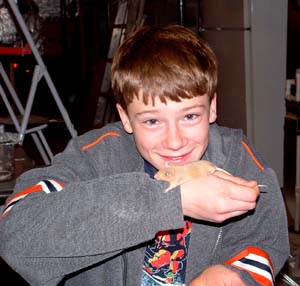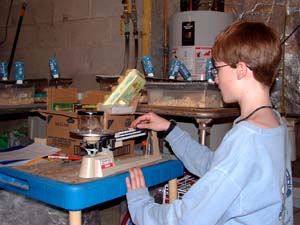
calls on trendy diet Brockport student puts mice on Atkins Diet The annual Science Fair is generally the time for projects like "how fast do various brands of ice cream melt" or "if you put baking soda and vinegar together can you make it explode?" But this year's Brockport Middle School's Science Fair had an entry that was both challenging and unique and it was no surprise that Jacob Gaskill was the boy to do it. Gaskill, a sixth grader, is what his former science teacher, Chris Albrecht, calls "a scientist to the core." Gaskill studied the effect of a low-carb diet versus a regular diet on laboratory mice. The Atkins Diet is a popular low-carb weight loss plan that restricts dieters to less than 20 grams of carbs per day. "I wanted to do something with mice and nutrition and I had heard some of my parents' friends talking about losing weight on the Atkins diet. I decided to try it on mice and compare the effects," he said. Realizing it was going to cost him some money for this project - not only to purchase the mice but also for all the materials he would need - Gaskill decided to offer his friends and family "mouse sponsorship packages." Each sponsor paid $5 for one mouse. In return they received mouse naming rights, individualized charts letting them know how their mouse was doing, and the option of taking their mouse home at the end of the experiment. While no one took him up on the mouse ownership option, all twelve mice were sponsored. This thought process impressed his mentor, Hill School Science Teacher, Chris Albrecht. "Without even knowing it, Jacob solicited his project and found funding. In the real world of science this is known as a "grant" and it's exactly what real research scientists have to do," Albrecht said. Gaskill figured out that to be comparable to the Atkins diet, each mouse could only have .1 grams of carbs per day. He put together a feed made from ground beef, pistachios, cheese, brazil nuts, eggs, parsley and watercress and put it in a blender to form a paste. He measured out and then froze individual feeding portions. Every day the six Atkins mice received one of the portions of the feed mixture while the other six got regular mouse feed purchased at the pet shop. One boast of the Atkins diet plan is that a person can eat as much as they want as long as it's a low carb food. Jacob made sure the Atkins mice received as much food as they seemed to want. He weighed each mouse every few days and carefully recorded the data. Every two days, he placed each mouse in a cage with an exercise wheel and tracked how many rotations they made in a two minute time frame. His findings? "Well it didn't seem to matter if the mouse was on the Atkins diet or a regular diet, but I found that male mice are far less active than females. The most rotations a male mouse made in two minutes was 63 spins whereas the highest female (mouse) did 100 spins." At the end of this 30 day experiment, Gaskill admits he was a bit surprised by the results. The Atkins mice gained 4.5 grams and eight percent increased body weight compared to the other mice which gained only 1.6 grams. The Atkins mice also consumed 60 percent more food. Like any good scientist he has a theory for his findings. "Mice don't know enough to stop eating like humans do. People know that to lose weight they have to eat less and so they do, mice don't know to do that." Mark Mrowka, Jacob's 6th grade science teacher, was pleased with his student's project. "The basic science fair project has to be a controlled scientific experiment. Most kids do things like comparing laundry detergent results. Jacob definitely took it to the next level. His project was not only a good controlled experiment but was also creative and unique and the judges will look positive on that." The Science Fair took place on Thursday evening, May 27. The judges were from Sigma Xi, a Science Honor Society from SUNY Brockport. Prizes for the top experiments in the past have consisted of items such as microscopes or other scientific equipment. As for the mice, unfortunately one died, two will remain in the Gaskill home as pets and the others have been returned to a local pet store. |

